The Kodak Ektra is one of the most interesting cameras of any I’ve ever written about on this site. In July 2019, I was able to get my hands on a working example and I wrote an in depth review of it sharing some of the only images shot with an Ektra in probably half a century.
That article has a great deal of information about the Ektra and it’s development, but a quick summary in case you haven’t read it is that in the late 1930s, Eastman Kodak foresaw a future disruption in supply of cameras and lenses from Germany with the growing turmoil in Europe and turned to some of it’s most skilled designers to come up with a premium system camera of their own.
The priorities for Kodak’s new camera were that it was to be a 35mm rangefinder camera with an interchangeable lens mount and the company’s highest quality lenses to compete with the German Leica and Contax rangefinders. Kodak’s German division had already been making the Kodak Retina in Stuttgart, but this needed to be made entirely in the United States. Kodak’s first American made 35mm camera was simply called the Kodak 35, and this new camera was appropriately called the Super Kodak 35.
Work had already begun on the Super Kodak 35 in late 1937 as the drawings from the US Patent to the right reveal a design very similar to that of the finished Ektra. You can clearly see the extra wide rangefinder base, fine focusing wheel, rear door film advance lever, shutter speed dials with speeds from 1 second to 1/1000, an adjustable dial with number 2 through 10 on it presumably to indicate focal lengths of 2 to 10 inches (51mm to 254mm), and a lens with a maximum aperture of f/2.0.
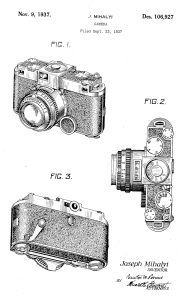
In a booklet published by Kodak in 1939 called Major Developments in New Apparatus, more information was revealed about Kodak’s new Super 35 camera. In it, were descriptions of features from the finished camera such as the magazine film back with integrated dark slide, zoomable viewfinder, adjustable diopter, precision focus wheel, and unique bayonet lens mount.
In addition to these known features, the Super Kodak 35 would have a few options available that would never be produced, such as:
- Nine lenses were planned instead of the six that were eventually produced. The three lenses that never made it were:
- 50mm f/1.5 Ektar (formula 315, focuses down to 1.5ft)
- 85mm f/1.6 Ektar (formula 160R)
- 254mm f/4.5 Ektar (4-elements, focuses down to 6ft)
- Wind up motor drive replacing the standard magazine. A single wind would allow for up to 12 exposures to be taken without having to re-wind the motor, advancing the film and cocking the shutter after each press of the shutter release.
- Optional photo electric unit (exposure meter) with automatic exposure capability. Cameras with this feature would have been an entirely different “deluxe” model with a different rangefinder that includes aperture priority automatic exposure by automatically varying shutter speeds between 1/25 and 1/1000 based on available light.
The entire section with complete specifications can be read in the PDF below, used with kind permission of Kodak collector, Charlie Kamermann.
Charlie was not only kind enough to share with me the scans from the prototype booklet, but he also was the only collector I was aware of that had an original Super Kodak 35 prototype. His example had a serial number 106 which suggests it was the 6th made, and was the lowest numbered serial number to ever turn up, until now.
In May 2020, I was alerted to a Super Kodak 35 prototype which appeared on eBay by my friend Dan Hausman. The camera being sold was in the collection of collector Bernhard Mecking who had picked them up from a seller in Rochester, NY. The lot was very large and had what looked to be a bunch of parts that weren’t clearly identified. In the pile of parts, Mecking saw what looked to be Ektra bodies, so he bought it.
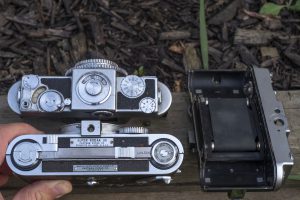
When it arrived, Mecking revealed that in the lot were seven Ektras, some of which were quite incomplete. Five had the top plate attached, and two were just body castings with a few parts attached. No lenses or other accessories were included. The rest of the lot was mostly partial Retinas and some Japanese TLRs.
Bernhard did not know anything about the seller, or who this collection of parts originally belonged to, but it’s location in Rochester, NY where Kodak was headquartered, strongly suggested it was likely someone who either worked for Kodak, or was in close contact with someone who was. Prototypes like these are usually destroyed when they are no longer needed, so their existence today suggests they were throw in a box and possibly smuggled out of the factory.
Upon closer inspection of his lot of seven Ektras, three turned out to be Super Kodak 35 prototypes. Unlike finished Ektras which have their serial number stamped into the side of the tripod stand, Super Kodak 35s typically have a three digit number etched into the left side of the film compartment. Charlie’s example above was number 106. Bernhard had 103, 108, and a third with no serial number.
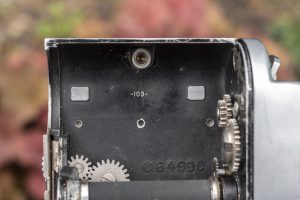
Super Kodak 35 Serial Number 103
Of all the known Super Kodak 35s, serial number 103 is the lowest numbered one that has been found. Was there ever a 101 and 102, or maybe even a 100 is anyone’s guess.
This camera has the familiar top plate of the Ektra, but shows some differences from the production model, the most obvious of which is the lack of the Kodak Ektra name. Other changes include:
- Missing accessory shoe on the right side of the camera. Body covering extends down to where it would appear on the Ektra, although two screw holes are present.
- No Red Signal window near the 7 o’clock position around the exposure counter opening to indicate whether the shutter is cocked or not.
- Completely different design for shutter speed wheel. On all Super Kodak 35s, the shutter speed was changed by a large wheel that slightly overlapped the rear edge of the top plate, and was gear coupled to a metal disc with shutter speeds on it beneath a window. On finished Ektras, a much smaller knob directly connects to this same disc and us turned by pulling up on it while rotating. It is not entirely clear why Kodak changed the design of this knob, but my best guess is that due to the nature of the Ektra’s shutter requiring it to be cocked before speeds could be changed, required changes to the original design.
- Shutter release button is not cable threaded. It’s possible it is cable threaded, and some type of “soft release” is screwed into it, but from the pictures I see, this does not appear to be the case.
- Viewfinder adjustment wheel has a setting for 152 instead of 153 on production Ektras. Kodak would eventually make a 153mm lens for the Ektra, so it makes sense to change this, however the difference between 152mm and 153mm in a telephoto lens is so small, no one would likely ever notice.
- Cosmetic difference in self timer lever. It just looks different.
- No raised frame around main viewfinder window. There is one on the right rangefinder window however, suggesting it would have been added at some point.
The rest of the camera is incomplete. Although the shutter curtains are installed, the ribbons have long since snapped. Even if they weren’t it is very likely that the shutter on this early example never worked.
There is no back, nor is there the plate around the shutter gate, fully exposing the shutter curtains and their reels.
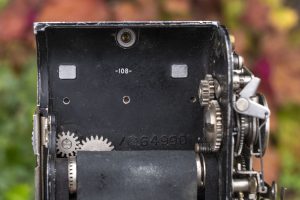
Super Kodak 35 Serial Number 108
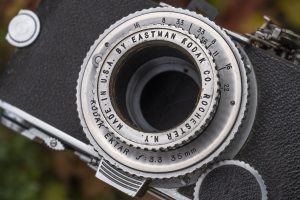
This camera is interesting as unlike the others, it is the only one found with a lens, or at least parts of a lens. Both the body and lens are incomplete with the wide angle Ektar 35mm f/3.3 lens missing all glass elements. The focus helicoid is intact as it rotates smoothly as it would have on a completed sample.
The serial number of the lens is EY849 indicating it was made in 1940 using Kodak’s CAMEROSITY code. Painted on an inner part of the lens in white letters with a red background is the number 133B-7 which I am unsure of what it’s significance is.
I have not seen a large enough sample of serial numbers for the 35mm Ektar lens, but the three digit serial number is certainly an early example. Whether or not this lens and body were always paired together is anyone’s guess.
The rest of the camera is missing the top plate and almost every piece of the viewfinder and rangefinder. The gears and other parts for the shutter speed dial appear to be intact and reveal the entirety of the shutter speed dial which is normally hidden under the top plate, which is also missing. This camera did not come with a back, nor did it have the film gate that would have covered most of the shutter. In the gallery below, I have a spare back from a production Ektra mounted, but the back you see in these images was not originally part of number 108.

Super Kodak 35 Unknown Serial Number
This final prototype is the most complete of the three here, and the only one that isn’t numbered. When Bernhard first acquired this camera, there was a yellow sticker with Kodak patents on it over the place where the serial number on the other prototypes was located. Looking up the patent numbers, none were related to the Ektra at all, so it was an easy decision to peel off the sticker, only to reveal nothing underneath.
Is this camera a post 108 prototype or possibly even an earlier one before they started numbering them, that somehow survived with more of it’s parts than the others? No one will likely ever know, but this unnumbered prototype gives us the best look at what a completed Super Kodak 35 might have looked like.
This camera has most of the same differences from a production Ektra as number 103 does, but with more parts giving us a better look at a finished camera.
- There is no plate on the bottom of the camera identifying this as a Super Kodak 35. Does this mean this was a transitional model after they decided to not use the Super Kodak 35 name, or was it before they decided to name it?
- Although this camera is also missing the accessory shoe on the right side, it does not have the two holes drilled through the top plate of 103.
- There are some changes to the body covering around the shutter speed dials on the left side including what looks to be some kind of metal filler on the far edge.
- The typeface of the numbers on the viewfinder adjustment wheel are different from that of 103 and a production Ektra. All the numbers have a narrower, less bold, engraving. The zeros are fatter, the ones have a serif near the top, and the number three has a flat top instead of a rounded one.
- The typeface of the diopter adjustment wheel is different too and bolder than the other wheel, suggesting these parts might have been made at different times.
- Still no raised frame around main viewfinder window, although now both rangefinder windows have it.
- Design of the arrow on the exposure counter wheel is much bolder with a multi-part vs single-part tail on the production Ektra. There is also a dot opposite the arrow on the same wheel of which the purpose is unknown.
Unlike the other prototypes, this is the only one with a complete viewfinder and rangefinder, both of which actually work well. There still is no back to the camera, but the film gate over the shutter is in tact. The shutter still does not work though, which like the other prototypes and many production Ektras are hard to find in working condition today.
With the previously known Prototype 106 in the personal collection of Charlie Kamermann, we now know of four Super Kodak 35s. Were there more? Probably, but whether they are still out there on some collector’s shelf, sitting in a box deep in the attic of another house in Rochester, NY, or if they were destroyed at some point in the last 80 years is anyone’s guess.
I love these glimpses into the past of what was. While these prototypes do not show any exciting features that were planned for the Ektra but later removed, I’ll be honest, the name Super Kodak 35 is pretty super!

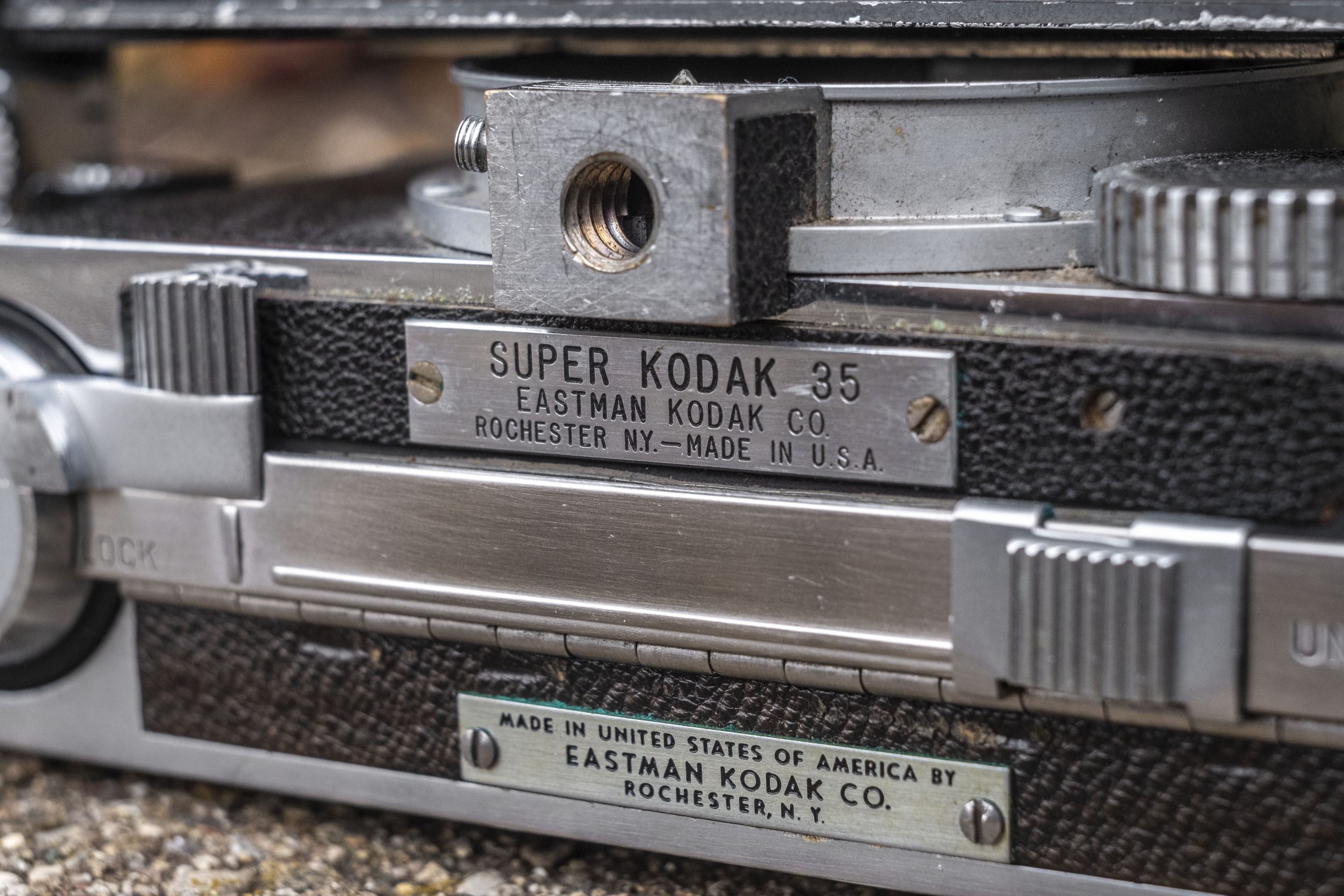
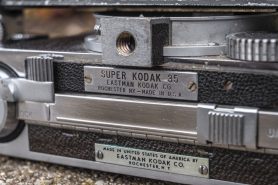
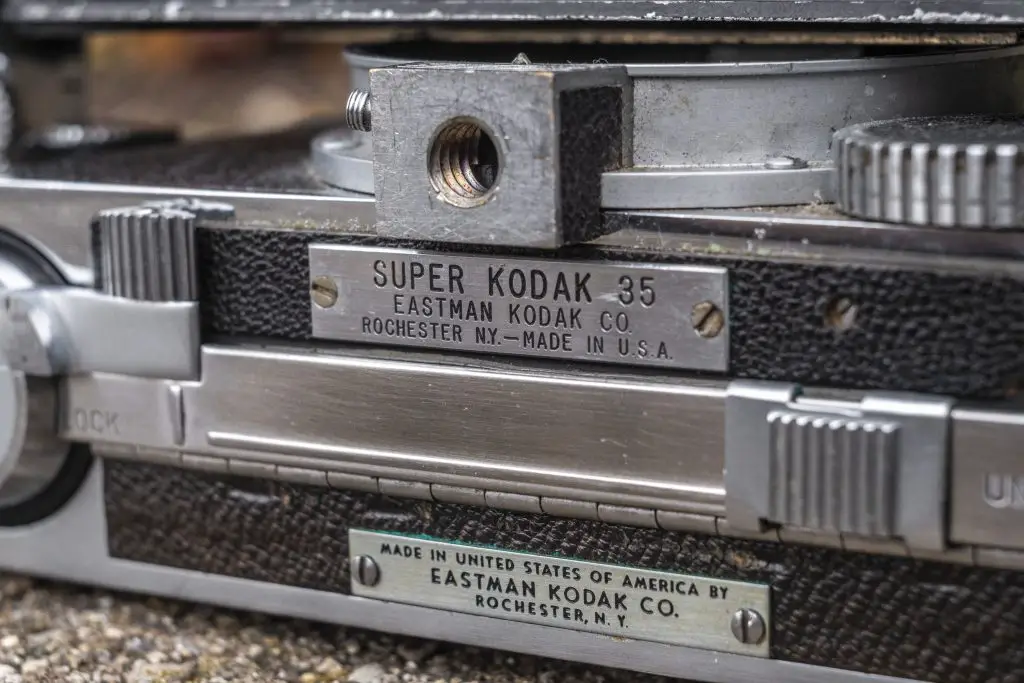






























Thanks for the information. This history of design change is interesting to camera technology geeks like me since I have fixed several Ektras. The shutter also did go through at least 2 changes that I have seen. There was an Extra2 as I understand but have never seen one.
Wow!!
What a cool story! Thanks for sharing it (and fueling unreasonable fantasies of odd-lot jackpots).
Glad you enjoyed it Andrew! It was a pleasure handling three rare prototypes all at the same time!